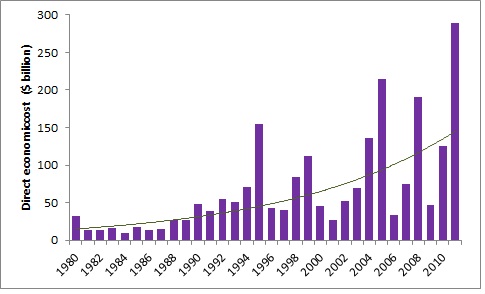3 April 2012
The need for investment in large-scale natural hazards research programmes
Posted by Dave Petley
It is an exciting day in the world of physics as the committee meets to decide the location of the Square Kilometre Array, a giant new radio telescope that will improve resolution by 50 times compared with existing instruments. This is a truly epic piece of science – it will for example collect data at a rate that exceeds the capacity of the entire global internet at present! The costs and timescales are also remarkable to observe – the project was first conceived in the early 1990’s, with construction expected to be complete in 2024. The estimated cost is 1.5 billion Euros ($2 billion).
This instrument is designed to address some really interesting scientific questions – for example mapping the large-scale structure of the cosmos. It is a part of a series of very large physics-based science experiments and facilities, including the European Extremely Large Telescope (budget: 1.1 billion Euros) and of course the Large Hadron Collider (budget: 7.5 billion Euros).
Now, natural hazards kill large numbers of people and inflict huge costs on society. This graph for example, which uses EM-DAT data, shows the direct losses associated with natural disasters since 1980. Note that this excludes the multiple indirect costs, which would multiply these totals many times over:
This is a really substantial, and rising cost, to society. There is widespread concern about either the trillion-dollar earthquake (in fact some estimates are that a large event in Tokyo could cost up to $2 trillion) or the million fatality earthquake (for example a very large event in the Himalayas could inflict this level of loss), both of which are statistically entirely possible.
So why is it that natural hazards research does not attract the level of large-scale investment that goes into physics? Allow me to cite an example. Two of the UK Research Councils – NERC and ESRC, are currently funding a major new research programme entitled Increasing Resilience to Natural Hazards, with two strands (earthquake and volcano). This is a genuinely exciting initiative, which has induced the creation of a raft of new consortia across natural hazards research in the UK. It is hoped that it will make a substantial impact in reducing losses from natural hazards over the next decade. But the total cost of the two majors grants that will be awarded is about £6 million ($10 million). Now, this is a large sum of money in anyone’s terms, and this programme is both ambitious and impressive, and it is very welcome. But in comparison with the investment in physics research it is really rather paltry.
If $10 million can make a large impact, one can only imagine the impact that a coordinated investment of $2 billion could have. I believe that such an investment could genuinely induce a step change in both our understanding of natural hazards, and in our management of them. The benefits to society, in particular in less developed countries, would be tremendous.
So surely it is now time for the natural hazard community to take the lead from the physicists. We should create a large-scale investment plan for a comprehensive, international research effort into natural hazards that is properly resourced and managed. The impact of such a programme could be enormous, but to do will require a long-term perspective and high levels of ambition.
No-one should under-estimate the complexity and difficulty of such an initiative, but this should not deter us.The average direct economic cost of natural disasters over the last five years has been $145 billion. Let’s that losses remain at this level (and of course they are in reality rising quickly). If the research programme were to cut these losses by just 10% per annum, the saving would be $14.5 billion per year in direct costs alone, or $290 billion over 20 years. That would make the investment extraordinarily good value for money. Perhaps as a scientific community we need to be a little more self-confident!



 Dave Petley is the Vice-Chancellor of the University of Hull in the United Kingdom. His blog provides commentary and analysis of landslide events occurring worldwide, including the landslides themselves, latest research, and conferences and meetings.
Dave Petley is the Vice-Chancellor of the University of Hull in the United Kingdom. His blog provides commentary and analysis of landslide events occurring worldwide, including the landslides themselves, latest research, and conferences and meetings.
There are 2 issues here. First, the 3 expensive physics projects you mention are all to build instruments. That evidently appeals to funders. In contrast, a “comprehensive, international research effort into natural hazards” will almost all be funding labor; we already have the instruments to perform such research, and they aren’t expensive. So, how are you going to make lots of labor hours as sexy as a $2 billion super-instrument?
Second, to get this level of funding for mega-projects you have to have an international mega-organization that provides the drive. For example, look at the consortium that is building the Extremely Large Telescope, the European Southern Observatory. Go to
http://www.eso.org/public/about-eso/memberstates.html and look at the annual funding of this organization for 2011. It was 131 million Euros last year.
So until we build such an organization for Natural Hazards research, we cannot realistically expect to fund your envisioned billion-Euro research project.
The ESO was founded in 1962, so it has taken them 50 years to get where they are today. So, if we start our international organization for research into natural hazards THIS YEAR, we might be able to fund your envisioned project by 2062.